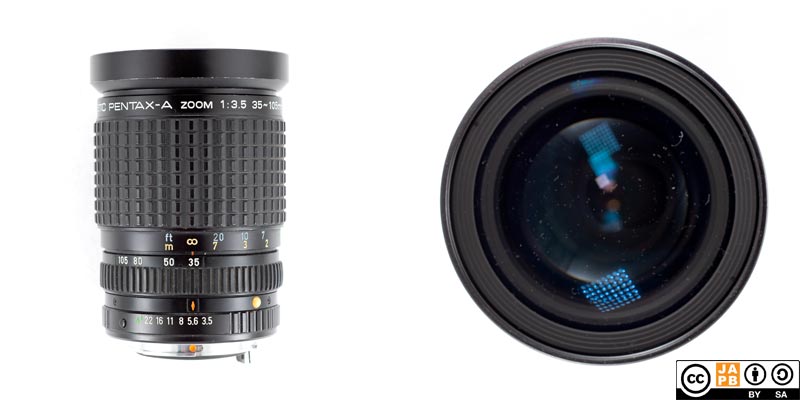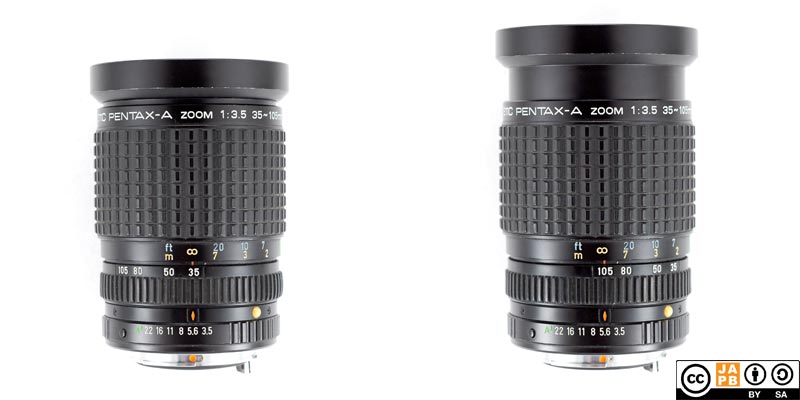Pekka Buttler, 06/2023

Specifications
The table below summarizes the lens’ key specifications (measurements are based on the pictured sample):
| Brand: | Asahi Opt.Co. (Pentax) | Lens name | smc Pentax-A 1:3.5 35~105 |
| Focal length(s) 1 | 35–105 mm | Angle-of-view 2 | 63–23 ° |
| Maximum Aperture | f/3.5 | In Production | 1984–1989 |
| Lens mounts | Pentax K | Subfamily (if applicable) | KA |
| Length 3 | 97,6 mm | Diameter 4 | 70,0 mm |
| Filter ring diameter | 67 mm | Weight | 618 grams |
| Lens element count | 15 | Lens group count | 13 |
| Aperture blades (S/R/C) 5 | 6 S | Focus throw | 90 ° |
| Minimum focusing distance | 1,5 m (see below) | Maximum magnification | 1:12,2 |
| Has manual aperture ring | YES | Has Manual focus ring | YES |
| Aperture mechanism type | Automatic | Aperture click stops 6 | 3.5•5.6•8•11-16-22 |
Further notes:
• This is one of those lenses though which major camera manufacturers tried to convince the recalcitrant audience of professional photographers that zooms could not only offer versatility, but also second-to-none image quality.
• With a fairly elaborate optical design (15 elements, 13 groups) and a constant max aperture (f/3.5) it is very clearly targeted at the professional user.
• Whenever photographers have a discussion about legacy-age zooms, this is one of the few legacy zooms that are mentioned as exceptions to the all legacy zooms suck -rule. In fact, among its users, it has the loving nickname stack of primes (in reference to its sharpness)
• Interesting, although it was widely loved even when new, it never received a follow-on as the autofocus 35–105 that followed it was significantly dimmer (and its IQ did not receive the same praise).
• While the lens’ regular MFD is a rather disappointing 1,5, it offers a ‘macro’ mode that takes the MFD down to about 70 cms (@105 mm) or 30 cms (@35 mm).
• It’s a two-ring zoom (one ring to focus, another to change focal length). The lens changes length both while zooming (longer focal length–>longer lens) and while focusing. The filter ring rotates while focusing in the normal (infinity–1,5 m) range (but interestingly not in the macro range).
• This lens is of the KA-subtype of Pentax K lenses and communicates aperture information electronically to a compatible body, hence enabling a wide range of automatic exposure modes on compatible bodies.

Right: Lens zoomed at 105 mm
History of Asahi / Pentax
The camera business today known Pentax was founded in 1919 as Asahi Kogaku Kogyo (Asahi Optical Company). Initially the company manufactured lenses for eyeglasses, later diversifying into projection lenses and even later into photographic lenses, supplying lenses for camera makers such as Konishiroku (Konica) and Molta (Minolta) and binoculars.
In 1952 – the year of the Helsinki olympiad – Asahi released the Asahiflex, the first Japanese 35 mm SLR. Together with its SLR cameras, Asahi introduced a line of lenses that carried the name ‘Takumar’, in honour of the founder’s brother.
In 1975 Asahi/Pentax introduced its own bayonet mount – The Pentax K mount – and phased out the production of m42 lenses and cameras. The name Takumar would remain on Pentax lenses until 1979 (and made some sporadic reappearances). The Pentax K mount is still a current mount, but it has several versions/generations. For details, see the JAPB article on the Pentax K mount.
Pentax was among the handful of Japanese camera manufacturers to keep up with the introduction of autofocus SLR cameras, and even survived the shift from film SLRs to digital SLRs (albeit somewhat struggling).
Versions
There was only ever the one version of this lens.
Adapting
If you want to natively mount this lens you need to find a functioning Pentax K mount SLR (or a dSLR) camera. Luckily that should be relatively easy as Pentax K film bodies were produced in their millions and most of them – especially those manufactured by Pentax – have a good reliability record. Alternatively, you can use this lens natively on any Pentax dSLR.
Adapting this lens to a mirrorless, full-frame digital camera is a breeze thanks to the lens having full manual controls (aperture ring, focus ring). You simply need a dumb adapter from Pentax K to your mirrorless system.
Due to the medium flange focal distance used by the m42 mount (45,46 mm), whether you can adapt this lens to other than Pentax’ dSLR mounts depends on which dSLR mount: Canon EF, and Four Thirds can mount Pentax K lenses using a simple adapter ring. Minolta/Sony A and Nikon F on the other hand are not as problem-free, and – to retain anything near infinity focus – the adapter will necessitate corrective optics. In all cases, your camera will work only in stop-down metering.
Footnotes
- Focal length is (unless stated otherwise) given in absolute terms, and not in Full-frame equivalent. For an understanding of whether the lens is wide/tele, see ‘Angle-of-view’. ↩︎
- Picture angle is given in degrees (based on manufacturers’ specs) and concerns the diagonal picture angle. Rule of thumb:
> 90 ° ==> Ultra-wide-angle
70–90 ° ==> Wide-angle
50–70 ° ==> Moderate wide-angle
40–50 ° ==> ‘Standard’ or ‘normal’ lens
20–40 ° ==> Short tele lens
10-20 ° ==> Tele lens
5-10 ° ==> Long tele lens
< 5 ° ==> Ultra-tele lens ↩︎ - Length is given from the mount flange to the front of lens at infinity. ↩︎
- Diameter excludes protrusions such as rabbit ears or stop-down levers. ↩︎
- S=straight; R=rounded; C=(almost)circular at all apertures. ↩︎
- Numbers equal aperture values on aperture ring; • intermediate click; – no intermediate click. ↩︎